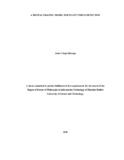A DIGITAL IMAGING MODEL FOR PLANT STRESS DETECTION
Abstract
Detection of stress in plants has been one of the many difficulties faced by the
farming industry in the developing world. This difficulty has been attributed to a
variety of factors, namely; reduced food production and consequent food insecurity,
and limited access to computing technologies that result to technological evolution
challenges among Kenyan farmers. With respect to the cause of these difficulties,
research indicates the need to experiment with a diversity of image processing
techniques, and formulation of algorithmic models that would tackle the challenge in
plant stress. These stresses require technological advances in image processing and
algorithms that can be used by local farmers in detection of plant stresses. Digital
image processing approaches based on relevant algorithms allows for precision
farming through detection and remedying of foreseen stress before it causes
destruction on the plants in the farmers’ fields. To achieve this, the general objective
of this study was to develop a digital imaging model for detection of plant stress for
enhanced productivity of crops and food security. In order to realize the general
objective, the study was guided by the following specific objectives; to analyze
existing image-based plant stress detection approaches; to establish the physical
features of stress in plants; to map the physical features into digital imaging signature
characterizing stress in plants; to develop a digital imaging model for plant stress
detection and to validate the digital imaging model for detection of plant stress. This
study was guided by positivism research philosophy, and explored existing models,
algorithms and image processing techniques for detection of plant stress, and studied
the growth of mobile telephony with relation to the need for food security. An
experimental research design was employed through embracing the Convolution
Neural Networks. The study resulted to a model that was developed and implemented
in a mobile application and web interface to enhance food security through detection
and monitoring of tomato pests and disease stress. The images were captured using
mobile phone cameras, acquired input images were preprocessed through resizing and
rescaling of images, whereas Gaussian blur, thresholding and dilating were used in
feature extraction. SoftMax was used for classification and optimization carried out
using the Adam Optimizer. Validation for accuracy of the model was based on
training steps, sets and epochs and TensorBoard was used in bid to validate the model.
The results of the study proved the reliability of the model in detection of stress using
the digital imaging model to be more efficient over traditional approaches of plant
stress detection. The findings of this study if adopted will contribute to increasing
food production and enhance food security, contribute to the body of knowledge on
digital imaging technology, and inform academic researchers, computer scientists,
policy makers in education, and all stakeholders in farming and agriculture, on the
implementation of new and emerging deep leaning technologies in improving existing
work.

